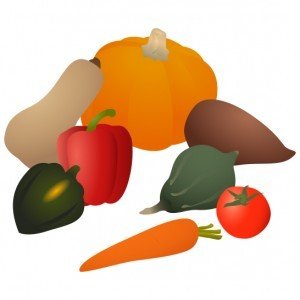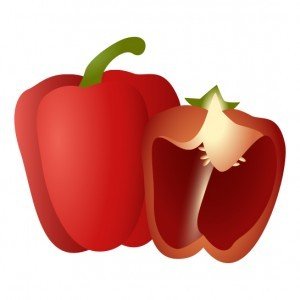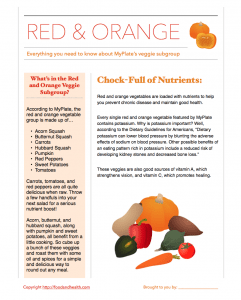MyPlate Exploration: Red and Orange Vegetables
Let's take a closer look at MyPlate.The vegetable group is made up of 5 subcategories:
Dark Green
Red and Orange
Starchy
Beans and Peas
Other
This division is based on nutrient content, and the theme of MyPlate's vegetable group is "Vary Your Veggies," with a recommendation to fill half your plate with fruits and vegetables at each meal.You probably know all this already.But it's time to breathe new life into MyPlate's vital nutrition lessons, and today we're starting a new series to do just that.Remember the Flavor Exploration series from 2014? In that collection, we took an in-depth look at amazing flavor powerhouses, examining their nutrient content, impact on health, history, and culinary uses. Now it's time to do the same thing with MyPlate's subgroups, starting with vegetables. Since there's already a detailed look at the joys of dark green vegetables, we'll begin our new exploration with red and orange vegetables.What's in the Red and Orange Vegetable Group?According to MyPlate, the red and orange vegetable group is made up of...
Acorn Squash
Butternut Squash
Carrots
Hubbard Squash
Pumpkin
Red Peppers
Sweet Potatoes
Tomatoes
What Nutrients Do These Vegetables Contain?*It probably won't be a shock to find out that these vegetables are loaded with key nutrients. Let's take a closer look at the heavy hitters.Vitamin A: Red and orange veggies are full of vitamin A. A single cup of raw, chopped carrots contains 408% of the daily value (DV) for vitamin A, and carrots aren't alone. Sweet potatoes have 377% DV vitamin A, while butternut squash has 298% DV vitamin A. Pumpkin weighs in with 171% DV for vitamin A too. Even red peppers, hubbard squash, and tomatoes have vitamin A to offer, with 58%, 32% and 30% DV, respectively. This vegetable subgroup is a vitamin A powerhouse.Vitamin C: Vitamin A isn't the only nutrient that these veggies have to offer. Many are also amazing sources of vitamin C. Red peppers, for example, have 196% of the DV for vitamin C in a single cup. Butternut squash offers 49% DV, and acorn squash deserves a mention for its 26% DV of vitamin C as well. Oh and don't forget about tomatoes, which contain 38% of the DV for vitamin C.Potassium: All of these vegetables contain potassium. Here's the breakdown of potassium content in a single cup of raw and cubed red and orange veggies...
Acorn Squash: 14% DV
Butternut Squash: 14% DV
Sweet Potato: 13% DV
Tomatoes: 12% DV
Carrots: 11% DV
Hubbard Squash: 11% DV
Pumpkin: 11% DV
Red Pepper: 6% DV
Vitamin K: Carrots are the vitamin K winners here, with 20% of the daily value for this nutrient in a single serving. Tomatoes, sweet potatoes, and butternut squash also earned honorable mentions in this category.
Of course, there's much more to the nutrient story of orange and red vegetables. Many contain manganese, folate, and vitamin B6, though in smaller amounts than the nutrients explored above. These foods are loaded with healthful nutrients!
What are the Health Benefits Associated with Red and Orange Vegetables?
All those nutrients make for one serious health boost. Let's start with the basics. MyPlate has clarified that "Eating a diet rich in vegetables and fruits as part of an overall healthy diet may reduce the risk for heart disease, including heart attack and stroke [...and] may protect against certain types of cancers." Making red and orange vegetables a part of your diet will help you reduce your risk of chronic disease.
Now let's look at what the particular nutrients in these red and orange vegetables will do for your health. Since vitamin A is a large part of so many red and orange vegetables, we'll start there. The National Institutes of Health assert that "Vitamin A helps form and maintain healthy skin, teeth, skeletal and soft tissue, mucus membranes, and skin. It [also...] promotes good vision, especially in low light. It may also be needed for reproduction and breast-feeding." A diet that is poor in vitamin A can lead to vision issues and a weak immune system, so stock up on those red and orange veggies!
Vitamin C is another nutrient that has wonderful benefits for your health. It promotes healthy teeth and gums, helps the body absorb iron, and promotes wound healing. What's not to love? It's good that so many red and orange vegetables are loaded with vitamin C. Plus, vitamin C is great for the immune system.
Of course, we can't forget about potassium! Since every single veggie in the red and orange vegetable subgroup contains potassium, let's take a minute to explore its health benefits. The Dietary Guidelines for Americans have named potassium a nutrient of concern, which means that most Americans don't get enough potassium in their diets. MyPlate reveals, "Diets rich in potassium may help maintain healthy blood pressure." The Dietary Guidelines for Americans build on this assertion, explaining, "Dietary potassium can lower blood pressure by blunting the adverse effects of sodium on blood pressure. Other possible benefits of an eating pattern rich in potassium include a reduced risk of developing kidney stones and decreased bone loss."We'll end today's discussion of the health benefits of red and orange vegetables with a closer look at vitamin K. Vitamin K is most well-known as a clotting vitamin because it is essential to proper blood clotting. Its name comes from the German "Koagulationsvitamin." How fun is that?
How Can I Make Red and Orange Vegetables a Part of My Diet?
All right, here comes the fun. Now that we've discussed why people should eat red and orange vegetables, it's time to talk about how to make those veggies a part of any eating pattern.
Carrots, tomatoes, and red peppers are all quite delicious when raw. Throw a few handfuls into your next salad for a serious nutrient boost!
Acorn squash, butternut squash, hubbard squash, pumpkin, and sweet potatoes all benefit from a little cooking. So the next time you feel like adding a hearty side dish to your meal, cube up a bunch of these veggies and roast them with some oil and spices for a simple and delicious way to round out any repast.
The fun doesn't stop there, though, because tons of free recipes feature these tasty foods, and they're all in the recipe archive. Some of my absolute favorites are featured below.
All of these recipes are healthful and rigorously tested. Which will you try first? Click the image above to download your free handout.
*Nutrient information from http://nutritiondata.self.com and explores 1 cup of raw, cubed or sliced vegetables.










